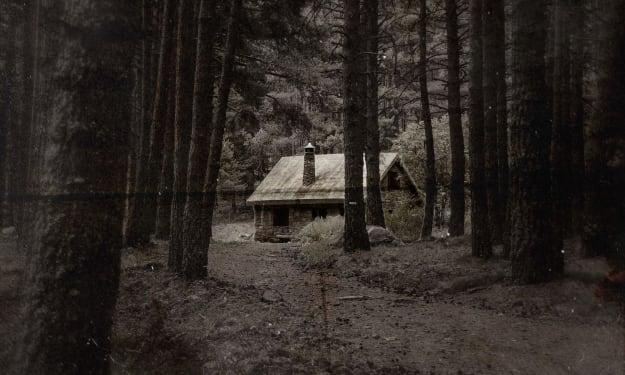The Passenger
All Aboard

Cold. In the heartbeats between sleep and wake, evening dew clinging to her eyelids, that is all she knows for certain. All she can feel.
Cold. It’s cold.
Then comes the texture, as the dew melts and the fog lifts. Snagged and smooth beneath hands she has yet to conclusively determine belong to her arms—which, in turn, do not seem to fit quite right against the lock of her shoulders.
It takes a minute, and if she were going to make it away from here to tell her tale, she’d probably smile with classy self-deprecation and say, “I can’t believe it took me so long to figure it out. It’s kind of embarrassing.” She’d look around in appreciation at the obliging laughter of her gathered friends. She’d raise a glass and drink.
She will not, actually, do any of those things, because she will not make it away from here to tell her tale. But it’s nice to think about.
Eventually her arms begrudgingly agree to support her weight and she props herself up. Knees curled beneath her, fingers splayed, she blinks. Once. Twice. Again. There is light, she knows, and it is near her; she can see it. It’s all she can see. She shakes her head. Clears her vision. Tries again.
First to take form is the thing she’s leaning into. Sitting on? A cracked plastic laminate, coating old brown leather seats. Passenger seats, she thinks, stretching out her arm and carefully feeling the length of the material. Half a body length, no more. She does not think about the origin of the syrupy fluid her fingertip just barely taps before she snatches it back—does not make the connection between its pooling location and where her head had lain just moments before.
The seat jostles. She jumps. Snaps her head up. Takes in, almost involuntarily, the rest of what she can see, color bleeding into the edges of her peripheral. Cringes away from the sudden influx of light.
In front of her is a seat identical to her own; behind her, the same. She reaches out and lays a gentle hand against the seatback closest her. The surface is the same, puckered and treated and puckered again. Signs of use, she assumes, turning in her seat. Signs of…
But to her left there are rows and rows of seats, and to her right there are rows and rows of seats, and across from her there is an aisle and sitting staunch and vacant next to that is another strip of them. Her legs do not yet feel anything but pinpricked and so she straightens only as high as her knees will take her to inhale the expanse of it, all the way down and all the way back, a hollow corridor with no beginning and certainly no end.
The seat jostles again. This time she does not take her eyes off of the seats in front of hers; she watches the wave as it travels, watches it sway each row in succession, hitting hers lightning-quick, bouncing off, bumping down the rows until she cannot see it any longer.
Her legs choose this particular moment to get their act together. In the wake of the turbulence, she stands, white-knuckled against the seatbacks on either side. She is not, she tells herself, letting go. Not for anything.
As though the corridor has read her thoughts it sends another wave her way, faster than the ones before. Angry. Testing. She does not have time to see it coming and when it hits her it is not her hands that make the choice to let go. The carpeting—she does not register the carpeting, though she with her bare feet has no good reason not to—undulates long after the wave has dissipated. She with her open eyes has no reason not to notice that, either, and yet she does not.
Instead she hones in on the windows, square and half-curtained and the source of that piercing ache pressing its wiry fingers against the backs of her eyes. She does not appear interested in the nature of the emitted light, only in its source. The corridor is not quick enough to stop her lunge across the aisle to the next row of seats, but it is no matter. She puts everything her body is willing to give her into forcing the window open and it is not enough. Which is not to say she is unsuccessful—she is. The window seal bursts and the glass flies up and the curtain whips and then she is back in the aisle and the window is closed. She blinks.
And then she does it again.
And again!
And then after half a dozen more attempts the whole thing loses most of its appeal. She reaches for the window once more, and the corridor rumbles. She speaks only two languages, and “corridor” is not one of them, but she seems to understand; she gradually drops her hand, staring straight ahead at the window the whole time.
When another wave builds in the distance she must suddenly figure out, if not where she is, what she’s on. The corridor sends up a whistle and characteristic train horn for good measure.
She laughs. It is out of place, here. The corridor eats the sound alive. She does not try to laugh again.
The horn, after several seconds of stillness, sends her scrambling to search her pockets. It is unclear why; there is nothing in them, and if she thought about it she’d find she does not recognize the clothes as her own, anyway. No familiar comforts are to be found in the depths of the fabric. She looks anyway.
“No ticket,” she says aloud, and the corridor does not take kindly to this. It is good of her to finally realize something of her own accord. It is, at the very least, progress. But the corridor does not enjoy words it cannot dictate and so here comes another wave and she sees it coming and her eyes widen and she barely makes it onto a seat in time, head over heels over head again. It jostles and it staggers but it is kinder than the aisle and she survives it.
Wearily she steps down into the aisle once more. The corridor accepts it. The movement beneath her feet quickens, the pulsing in her chest with it. She is moving, she knows, has been since before she woke. But the corridor—the train—is not slowing, nor is it keeping pace. The windows reveal nothing. They do not need to.
She stands, rocking slightly, as the corridor accelerates.
Silent—she will not say another word of her own for a time—she surveys the rows of seats extending in front of her. The corridor lists as though it has hit a rock, or a bump, or has taken a turn at breakneck speed; the light through the windows flickers. One two three. Beat. Three four five. Beat. One two
Her breath catches and she whirls around, chest heaving, reaching for the reassurance of the unyielding seat beside her. Her hand misses the seat and falls to her side and she is alone in the corridor and she is unsteady in the corridor and the lights are spasming in the corridor and she is tilting in the corridor and the seats are empty in the corridor and the seats are growing darker in the corridor and the seats are rushing towards her in the corridor and there is someone in the seats in the corridor. There is someone in each seat and the light blinks and there is another. And there it goes and there it goes again and they are coming to her and they are getting closer and she is stepping back and there is nowhere to go.
Nowhere to go.
The light flickers again. Pulses brighter. Pulses darker. Throws her in extremes until she’s dizzied. Keeps going long after.
Each burst of light through the windows marks a new passenger in a seat, each plunge to darkness a reset and a lurking fear. Light, passenger; dark, quiet. Light, passenger; dark, breath. Light, passenger; dark, scream.
The flickers build and they pulse quick and thrumming in her ears and filling her mouth and the corridor sways and she cannot bring herself to fall and she is frozen to the aisle and the passengers are nearing and she blinks and the lights flicker and the passengers sweep by her and the rows beyond and beyond and beyond shudder full. One passenger to each seat. One passenger on either side of the aisle. One passenger on the right and one passenger on the left.
She exhales.
It is brief.
From her right comes a claw and the passenger has a hand cinched around her wrist and it is bony and it is angular and it is warped and it is not letting go. Her eyes widen and she opens her mouth and no sound frees itself from the prison of her throat and the passenger swivels and the passenger meets her eyes and the passenger grins and the passenger grins and the passenger grins and she wishes the passenger would not.
“You’ll notice,” the passenger clicks, the voice spilling from the dry ravines of their lips sinking deep with disuse and foray, “we left a seat open.” The passenger’s head tilts. The beat of her heart plunges to her stomach.
Inch by inch she follows the passenger’s line of sight. Turns her body to the seat opposite them. The empty seat opposite them.
The light flickers. The passenger’s hand drops. The light flickers. She has taken a step forward. The light flickers. The passenger is facing forward. The light flickers. It is like she no longer exists. The light flickers. She is sitting in the center of the empty seat. The light flickers.
In a stroke, all of the passengers are gone.
Light filters in through the windows. Steady. Unblinking.
The train bears on.
About the Creator
Lyndon Beier
(they/them) enjoys exploring various themes surrounding identity and escapism in their work. They've been featured by blueprint magazine and their local public library system, and were awarded “Poet of the Year” by NEHS in 2022.
Reader insights
Outstanding
Excellent work. Looking forward to reading more!
Top insights
Compelling and original writing
Creative use of language & vocab
Easy to read and follow
Well-structured & engaging content
Excellent storytelling
Original narrative & well developed characters






Comments (1)
I really like your writing style! Your use of rhythm, repetition, and sentence length really kept me engaged and is a technique I'm looking to get better at! Some favorites: "In the wake of turbulence, she stands" "It is good of her to finally realize something of her own accord." (These two seem symbolic to me/have a deeper meaning) "And there it goes and there it goes again and they are coming to her and they are getting closer and she is stepping back and there is nowhere to go." (This really encapsulated her panic. I think you tried to do the same thing with the really long sentence just before this one about the corridor, but that one was a bit too long, I think, but still did a good job showing the feeling of being surrounded/caught in anxiety's grip) I also like how, at the end you kept repeating 'the light flickers'. It really immersed me into the scene and makes the ending even more interesting and memorable! I hope you've got more, because I'm subscribing!